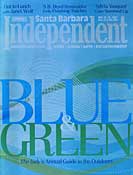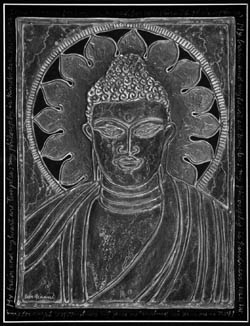

Thoughout Space and Time
Buddha Abides, presented by Frameworks, at Sullivan Goss Gallery
Thursday, May 17, 2007
By Beth Taylor-Schott
The Buddha taught that everything is burning, a metaphor that reminds us of the impermanence of everything around us. According to this way of thinking, things that actually burn only manifest this nature more obviously and dramatically than those that don’t. This is probably of little consolation to Christi Westerhouse and David Cort, owners of Caruso-Woods Gallery/Frameworks, which was recently destroyed in a fire.
 But they are more likely encouraged by Buddhist notions of inter-being, which emphasize how everything continues throughout space and time, nothing being limited by a separate self. Certainly, this has been the case with their monthly 1st Thursday event and annual benefit, which have, in the wake of the fire, multiplied from a single location on De la Guerra Street to many other locales and events. Buddha Abides, their annual benefit for Domestic Violence Solutions for Santa Barbara County and Tibetan Children’s Village in Dharamsala, appeared at Casa de la Guerra for May’s 1st Thursday, and is now on display at Sullivan Goss. A benefit for the couple and their soon-to-be-born daughter was also held at Haggle on 1st Thursday, and Indigo Interiors hung works donated by more than 30 local artists — including Mary Heebner, Linda Saccoccio, and Marcia Burtt — for a benefit auction held on May 11. This Friday, May 18, a benefit for the fire victims, including the upstairs neighbors, will be held at Casa de la Guerra, with music by Spencer the Gardener.
But they are more likely encouraged by Buddhist notions of inter-being, which emphasize how everything continues throughout space and time, nothing being limited by a separate self. Certainly, this has been the case with their monthly 1st Thursday event and annual benefit, which have, in the wake of the fire, multiplied from a single location on De la Guerra Street to many other locales and events. Buddha Abides, their annual benefit for Domestic Violence Solutions for Santa Barbara County and Tibetan Children’s Village in Dharamsala, appeared at Casa de la Guerra for May’s 1st Thursday, and is now on display at Sullivan Goss. A benefit for the couple and their soon-to-be-born daughter was also held at Haggle on 1st Thursday, and Indigo Interiors hung works donated by more than 30 local artists — including Mary Heebner, Linda Saccoccio, and Marcia Burtt — for a benefit auction held on May 11. This Friday, May 18, a benefit for the fire victims, including the upstairs neighbors, will be held at Casa de la Guerra, with music by Spencer the Gardener.
Meanwhile, Buddha Abides sits quietly at Sullivan Goss, its many Buddha faces smiling with equanimity. As in past years, collage and assemblage are the mediums closest to hand for expressing the multifaceted aesthetic Buddhism seems to invoke. For this reason, works in other mediums stand out, including “Digital Buddha,” a print by Stephen Fields; “Offerings,” a kiln-formed glass by Judith Geiger; and “Mangala, Godess of Long Life” by Susan Seaberry. Several artists whose works were notable in years past reappeared; be sure to catch “Sacred Union,” a provocative watercolor by Meganne Forbes, and “Golden Pavilion,” a gorgeous photograph by Chris Messner. This year’s Buddha Abides is as rich an exhibition as ever, and the title of Lyn Gianni’s acrylic says it all: “There Is No Need for Temples.”


No Buddha, No End of Buddhas
Buddha Abides
Originally published 12:00 p.m., May 25, 2006
Updated 01:25 p.m., May 26, 2006
By Beth Taylor-Schott
Reviewed by Beth Taylor-Schott
The first precept offered to lay order members by Buddhist teacher Thich Nhat Hanh begins thus: “Aware of the suffering created by fanaticism and intolerance, I am determined not to be idolatrous about or bound to any doctrine, theory, or ideology, even Buddhist ones.” The curators and artists of Buddha Abides, now at Caruso Woods through June 17, seem to have taken a similar artistic vow.
The show’s call for entries states that works “must reflect Buddhist themes.” It turns out that they need not necessarily include the figure of the Buddha himself. In “Buddha Abides” by Sally Chiu, only the stenciled word “Buddha” emerges over and over from a Rothko-esque background. A lush photograph by Chris Messner, “Bamboo Forest,” depicts only the plant, a Zen symbol for Buddha nature. “Wing and a Prayer” by Annette Matrisciano distorts, beyond recognition, not just the Buddha, but the human figure as well.
More often the works do include a recognizable Buddha. At times, this figure is one element in a larger collage or assemblage. Rosemary’s “Bloom & Bless” arranges rose petals in concentric, lotus-shaped circles, with a simple gold-stamped Buddha at the center. “Buddha with Birds” by Marcelino Jimenez presents the Buddha as part Baroque fancy, part St. Francis. Other works represent the Buddha in entirely Western idioms. “New Moon Buddha” by Linda Cassierer creates the Buddha out of patchwork, while in “Buddha of the Southwest” by Bruce Birkland, the Buddha emerges as an enormous striated stone figure, blending in with the mesas and canyons around him.
The most successful works integrate Buddhist notions on the deepest levels. “Me as Buddha,” a watercolor by Meganne Forbes, asks us to see the Buddha as a beautiful, female nude, painted in the manner of a monumental tarot card. “Bamboo Buddha,” by Blake Lannon, offers a bamboo grove alive with shape and color as if at the moment of awakening, an indistinct Buddha statue tucked into the greenery.
The show even has room for a work that, except for its size and mounting, could pass for a Tibetan thangka, or religious scroll painting. But “Amitabha,” Buddha of Infinite Light, which takes pride of place in the gallery window, was not painted by a traditional artisan. It is the work of Tamarind Rossetti, a native of Ojai, who created the work using a book written in Tibetan, which she could not read, forcing her to depend entirely on its diagrams. The Buddha taught that there are 84,000 dharma doors, or paths to enlightenment. As this show makes clear, there are at least as many ways of depicting them.
